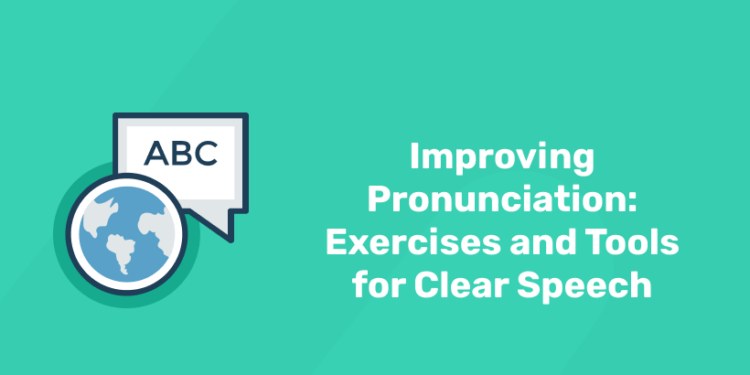The pronunciation of words has changed over time, but English spelling has not. For language learners, pronunciation presents a significant obstacle. However, accurate pronunciation goes beyond just “how words and letters sound.” There are other equally significant aspects to take into account as well, such as intonation (how the voice tone changes during a sentence, going up or down), stress (which words and syllables carry more of the weight when we speak), and connected speech (how words can sound different when they are joined together in natural speech). Good pronunciation is aided by all of these characteristics, but don’t mistake them for accent.
There are a huge variety of accents in the UK, the USA, and other English-speaking nations, yet all of these accents are deemed to have correct pronunciation. You don’t have to sound British or American when learning English. Being understood is more important than sounding like you were born in New York or London. Actually, a lot of natural English speakers enjoy listening to English with a Spanish, Italian, or French accent! How can you therefore improve your pronunciation so that you can maintain your regional accent while yet being understood by others around the world? Here are the top six suggestions to help you practise and improve your pronunciation.
Elevate your speaking skills with our Spoken English Course! Book a Free Demo!
Listen!
The most obvious technique to enhance your own pronunciation is to listen to cases of real speech. There are several methods to achieve this, like seeing a movie in its original language, listening to podcasts in English about a subject that interests you, or even just listening to music. Try to pay attention to how others employ intonation. ‘Shadowing’ can be used to add to this. Shadowing entails hearing a brief sentence or phrase spoken, then repeating it while attempting to mimic the sounds, intonation, and word stress. You should also pay attention to how your mouth and tongue move when speaking.
Record Yourself
Once you’ve gotten some practise shadowing, you might want to videotape yourself speaking. You could do this by either repeating a brief phrase you’ve heard or by doing a larger speaking assignment from a coursebook, such describing a picture. Record yourself again after practising any difficult words or noises that you heard when you listened to the recording. Can you see a difference?
Get to know the Phonemic Chart
A graphic representation of various sounds is provided by the International Phonetic Alphabet (IPA). It may sound unusual and appear as though you are learning a completely new language, but it can truly aid in your pronunciation. Every dictionary includes a phonetic transcription of each word so you may learn how to pronounce it. This is particularly useful for English because, as we’ve already seen, the spelling doesn’t necessarily match the sound. The words “thought,” “through,” “tough,” and “ought” all include the letter “ough.” Consider them. It is impossible to guess how to pronounce those words without assistance.
Use a Dictionary
There are many online dictionaries where you may click and hear the word being uttered, in addition to printed dictionaries that will offer you a phonetic transcription of a word.
Do some Exercise!
Our mouths adjust to the diverse sounds that different languages make. We have a really hard time physically producing some sounds because they don’t occur in our native tongue. It’s crucial to train your lips to know how to produce new sounds; just like learning a new sport or dancing routine, the more you practise, the easier it gets.
Get to know your minimal pairs
Minimal pairs are words with nearly identical pronunciations that differ only in one sound, as in the case of ship and sheep. The length of the vowel distinguishes the sounds /I/ in “ship” from /i: in “sheep.” Many language learners find it challenging to hear because it appears in so many distinct terms. Being able to distinguish between sounds when you hear them is the first step.
The Best Exercises to Improve Your Pronunciation
It’s time to find some workouts and techniques to improve your pronunciation now that you know what’s involved. Again, keep in mind that the majority of tactics call for you to videotape yourself.
Basic recording strategy
Look for something you can read aloud, like Shakespeare. Listen to a recording of yourself that you made with a microphone.
Yes, hearing your own voice might be strange or unsettling. But if you want to get better, you must do it.
Pay close attention to your weak points (such as the ‘th’ sounds, halting in the appropriate spot, etc.) and make note of where work needs to be done.
To make the recording better, do it again.
Keep in mind that you don’t require an elaborate or pricey microphone. Your phone’s or laptop’s microphone will work just fine.
Shadowing
Shadowing is the practise of speaking immediately following another person, much like a shadow.
You could, for instance, follow along with a TED lecture or audio by repeating every word the speaker says around 30 seconds after they say it.
You can improve your pace, word stress, sentence stress, and chunking by doing this. This should be done with a speaker who speaks at a slow to medium tempo.
Try shadowing the second time you listen to make it simpler by listening the first time without it.
Using Transcripts
You will work to make our pronunciation as natural and fluid as you can with this activity.
You must select a podcast with a transcript for this exercise.
Step 1: First, give the audio a listen at least once.
Step 2: Read the transcript aloud while recording yourself. Feel free to follow the tempo and mannerisms of the original speaker.
Step 3: Play it back and compare it to the original recording in step three. What’d you think? Give yourself a score of 1 through 10.
An alternative strategy is to record oneself reading the transcript before listening to the audio.
Try to picture how a native speaker might pronounce the text while you record. What phrases would they emphasise? What audio might be related?
Start speaking English like a native with our comprehensive course! Get Free Demo!
Pay attention to your tongue
Your tongue is where rice and lice vary most significantly. Your tongue is moved to produce sounds while you talk. You do it without thinking, so it’s likely that you weren’t even aware of that. It’s a good idea to pay attention to what your tongue is doing in order to improve your English pronunciation.
The letters “L,” “R,” and the sound “TH” are among those that are challenging for non-native speakers to produce. It’s all in the tongue how to pronounce them right!
- To make the “L” sound – The top of your mouth, right behind your teeth, and the rear of your front teeth should be in contact with your tongue.
- To make the “R” sound – You shouldn’t let your tongue rest on your top of mouth. Reposition your tongue such that it is close to where it would normally be if you were not speaking. Your lips should be slightly rounded when you make the sound. Say the word “right” a few times. You should feel air blowing between your tongue and the top of your mouth as you speak. You should also feel your lips get a little rounder when you make the sound.
- Now for the “TH” sound – Put your tongue in between your top and bottom teeth to produce this sound. The sound is created by letting some air escape between your tongue and teeth as you exhale. Your tongue should protrude slightly between your teeth. utter the word “think.” Several times, say it. Ensure that your tongue is inserted between your teeth.
Add stress to sounds and words
English is a language with emphasis. Thus, some words and sounds have a greater significance than others. When you speak out, you may hear this. As an illustration, the word “introduce” is spoken with emphasis at the end, as in “in-tro-DUCE.” The meaning of a word can occasionally alter depending on where the stress is placed. Out loud, say the word “present.” If you used the word “Present,” you are referring to a noun that either denotes “this very second” or “a gift.” If you responded with the word “preSENT,” you are using a verb that meaning “to give or show.”
Keep in mind that the first syllable of most two-syllable nouns is stressed, while the second syllable of most two-syllable verbs is.
The best method to learn is to practise and listen, so don’t worry if this all seems too difficult to remember. Keep in mind that the majority of native English speakers don’t grasp the rules either; instead, they simply say what “sounds right.” You can learn to obtain what sounds right with enough practise.
Write out difficult words by their sounds
Having issues with specific words? Write them out if you can.
Not just the term, though. Try writing it out phonetically, using the sounds of the words rather than the spelling.
Say you have trouble pronouncing the word “pizza.” The phonetic spelling is pits. As you can see from the phonics, the double-z is sounded like a “ts.”
Make some flashcards. On one side, write the word; on the other, phonetically spell it. You can highlight the letters you’re testing yourself on on either side if that helps. (Visual learners may find this to be particularly helpful.) how-to-improve-english-pronunciationIt can be challenging to write things out phonetically, especially if it’s in your second language.
Write down what you hear
Want to improve your pronunciation of English? Recline and pay attention. When someone is speaking, pay attention and take notes. But listening is a fantastic technique for improving your English pronunciation.
Practice with tongue twisters
Do you occasionally have trouble distinguishing between similar sounds in English, such as “sh” and “ch,” “t” and “th,” or the short and long “e” sounds? You’re not alone, so don’t worry. Tongue twisters can be a challenging (but entertaining!) exercise in sound distinction. Given how similar many of the sounds are, these are poems that can be challenging to recite.
People use them in English-speaking nations simply because they find it amusing when you make mistakes and sound dumb. And after you complete the poem, you’ll feel accomplished! These popular and successful English tongue twisters are an excellent way to practise the “s” and “sh” sounds:
“She sells seashells by the seashore.”
That tongue twister has a long history. But after you’ve mastered that, try including a few less well-known lines:
“The shells she sells are sea-shells, I’m sure.
For if she sells sea-shells on the sea-shore
Then I’m sure she sells sea-shore shells. “
Join our Spoken English program today and communicate with ease!
Practice with a buddy
It’s true as always: “Practise makes perfect!” Additionally, practising with a companion is simpler. Find a partner with whom you can practise pronouncing words, either in person or online. You will be able to put all that you have learned into practise while working with a friend and picking each other’s brains for new ideas. It’s also enjoyable!
Speak as much as you can
If you don’t speak much, you could have anxiety when it’s eventually time to speak in English. Like playing a game of basketball. You might be adept at dribbling, passing, and running, but you’ll never be able to shoot the ball.
It would be challenging to shoot when the game is in session. You can even get paralysis from nerves if you try anything new in front of other people.
The same holds true for using English. You should practise your English pronunciation in addition to overcoming your shyness in order to feel at ease speaking in front of others. Nervousness can cause many blunders, particularly when it comes to pronunciation.
Make the following rule for yourself: At home, you must speak English to yourself. Start by simply recounting your activities as you prepare dinner or get ready for bed. Make a commitment to yourself to talk aloud for at least a few minutes each day.
Set a schedule and stick to it!
The last stage is to make a plan and follow it. The greatest approach to get anything done, including improving your pronunciation, is to have a routine. For instance, if you schedule an hour a day for English study, set aside 20 minutes for practising your pronunciation. Alternatively, if you have two hours set aside for English, allot 30 minutes to working on your pronunciation. The duration itself is not that significant. The most important thing is to follow a routine. I guarantee that if you do this, your progress will be steady.
learn spoken english and speak fluently !
Improving Pronunciation: Exercises and Tools for Clear Speech – FAQs
Q1: What are the important aspects of pronunciation?
Ans: Pronunciation of individual sounds, Word stress, Sentence stress, Rhythm, Intonation.
Q2: How long does it take to improve pronunciation?
Ans: The amount of time required for effective accent removal varies depending on the individual. However, after 3–4 weeks of consistent practise, the majority of participants claim to have noticed an improvement in their English pronunciation. There is a significant improvement in their speech clarity and accent reduction after six months of practising.
Q3: Does pronunciation affect fluency?
Ans: It is obvious that heavy accents seriously impair verbal fluency. You will need to give up some poor habits and pick up improved pronunciation and enunciation strategies to make yourself more understandable in conversation.
Q4: Does reading improve pronunciation?
Ans: One of the most effective exercises for pronunciation improvement is reading aloud. Regularly reading aloud serves as a review for the pronunciation you’re learning.
Q5: Why is improving pronunciation important?
Ans: You might be surprised to learn that perfecting your pronunciation will make learning English easier. This is due to pronunciation, which makes you pay more attention to how speakers employ the appropriate sounds when they talk.
To find out more about spoken English, watch the video from the ENTRI English YouTube channel. It will be very helpful to watch one of their many videos on spoken English.
Speak confidently and fluently with our Spoken English Course!










